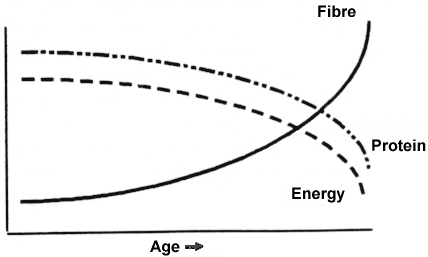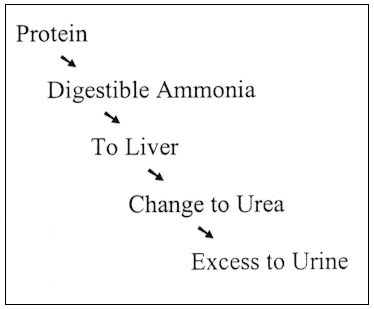Understanding Forage Quality and Winter Feeding of PMU Horses
Objectives of a Balanced Ration
- To get mares on-line through the production period in a healthy, sound condition.
- To produce adequate volumes of high quality urine.
- To produce a healthy, vigorous foal.
Formulating Rations
There are five basic components which must be provided in the right combinations in any animal diet. These are energy, protein, minerals, vitamins and water.
The basis for ration formulation should be feed analysis. Feed testing is inexpensive and will allow you to develop a feeding program to meet requirements, while staying away from any unpleasant surprises.
Energy
Rations for on-line mares are based on medium quality forages primarily as a method of keeping total protein levels in the ration at a maintenance level required for gestating mares. Forages are high in protein and energy and low in fibre during early growth stages. As they mature fibre levels increase, resulting in a decrease in protein and energy. Feeding mature low-protein forages requires supplementation with oats or barley grain as an energy source to keep the mares in good body condition.

The amount of grain required will depend on the quality of the forage, and the size and present body condition of the mares. The general recommendation is to feed one pound of grain per 100 pounds of body weight. Mares are in good body condition if their ribs cannot be seen, but can be felt with light pressure. The function of the high fibre forage is to provide fill and to keep the gut functioning properly.
Protein
Meeting the minimum protein requirement is absolutely necessary to ensure a healthy and vigorous mare and foal.
Protein requirements on a 100% dry matter basis are 9% - 10% during early gestation and 10%-11% during the last 90 days of gestation. Approximately 70% of the growth of the fetus occurs during the final 90 days of gestation.
Excess protein must be avoided.
Protein is broken down in the gut and absorbed into the blood stream as ammonia. Blood from the gut goes to the liver where the ammonia is converted to urea. If there is more protein than required, blood urea begins to rise. The body, in trying to maintain a constant level of blood urea, excretes any excess in the urine.

Grass Growth
Grass crops for hay and pasture are produced on a wide range of soil types and under variable climatic regimes. Growth in grasses may be divided into two phases - vegetative and reproductive. Vegetative growth is associated with younger plants and the production of leaves. No stems are associated with this phase. At boot, the developing seed head of the grass is enclosed in the flag leaf sheath but is not yet visible. The reproductive stage of the grass plant occurs at heading when the seed head emerges from the flag leaf. When pollen is shed, you will notice a powder-like substance on the heads of the grass, this is called the flowering stage.
Harvest Time
Protein levels of different grasses can be altered by different cutting times. Grasses cut just after flowering will have a protein level in the range of 16%. The same grass cut two to three weeks later will have a protein in the range of 8% - 10%. This later range is suitable for grasses used in formulating rations for mares on-line.
Climatic Effects
Cool, wet conditions result in a slow drop in protein levels as grasses mature. Hot, dry conditions will result in a rapid reduction in protein levels.
Grass Categories
There are two categories of grasses in Manitoba - basal type (pasture) and joint stem (hay).
Basal type (pasture) grasses
Basal type (pasture) grasses have the growth point remain near ground level until late in the season, when a seed stalk will appear if the grass is not grazed. Basal grasses are high producers of leaves compared to stems, therefore, they are best suited for pasture. These pasture type grasses have good growth potential after grazing or cutting. The protein levels generally are higher in pasture grasses if left to maturity - simply because you have lush leaves at the bottom even though the stalk and seed head dry down at maturity. They can be difficult to put up as hay. If moisture conditions are good at cutting time, the new regrowth will grow through the swath, making curing difficult.
Grasses in the basal leaf (Pasture) category are:
- Meadow Brome
- Meadow Fescue
- Orchard Grass
- Russian Wild Rye
- Tall Fescue
Joint stem grasses
Joint stem grasses are best suited to hay production. The growing point is located near the tip of the plant throughout the growing cycle, moving upward as the plant grows. They have less leaf growth and produce more stem material as they get older. If they are grazed at an early stage (6 inches), the growth point is removed. The result is little or slow regrowth, as new growth has to originate from underground shoots. The protein level of hay type grasses seems to fall quicker as they mature, compared to the pasture type grasses.
Hay type grasses include:
- Crested Wheat
- Smooth Brome
- Tall Wheat
- Reed Canary
- Timothy
- Intermediate Wheat
- Slender Wheat
- Pubescent Wheat
Samples of grasses (below)were taken from three locations in the Southwest Region, (Virden, Deloraine, Shoal Lake) for growing seasons - 1993, 1994, 1995, and 1996.
The first harvest date each year was at time of flowering and subsequent harvests at two week intervals, approximately, depending on climatic conditions.
Table 1: Protein Data
EACH SAMPLING DATE IS AN AVERAGE OF THREE SITES HARVESTED ON THE SAME DAY. | |||||||||||||||||||||||||||||||||||||||||||||||||||||||||||||||||||||||||||||||||||||||||||||||||||||||||||||||||||||||||||||||||||||||||||||||||||||||||||||||||||||||||||||||||||||
